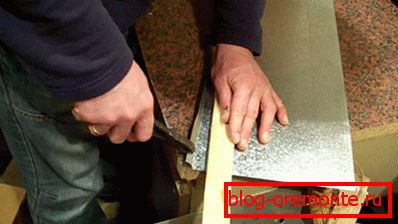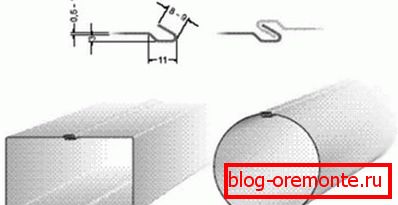Homemade chimney from a steel pipe do it yourself - step by
Each residential or even country house, bath, not connected to the central heating system, is supplied with a heat generating device. To remove from the interior of the combustion products of the fuel in the furnace they are supplied with a smoke exhaust channel. The most affordable option is a galvanized chimney, in the building stores the price of a 1 m pipe made of this material is about 110 rubles. If we add to this the cost of turning elements, deflector and brackets, the installation will cost a pretty penny. However, in this article we will explain how to cut costs by 60% and how to make a chimney out of a steel pipe with your own hands.
Main settings
Plus the store models of galvanized steel chimneys is that manufacturers produce a wide range of sizes. In addition, among the factory products can be found two-circuit, equipped with thermal insulation, corrugated, with increased flexibility and single-circuit. Making homemade chimney, it is necessary to be limited only to single-flow pipes. In order for the smoke removal system to work efficiently, the following parameters should be considered:
- The size of the pipe section. To smoke coming out of the furnace turn the chimney, you need to choose the right diameter of the pipe. Too thin pipe does not provide the proper level, in connection with which the reverse thrust can be formed. A large-diameter chimney, on the contrary, removes the combustion products into the atmosphere too quickly, so fuel consumption and energy loss increase. The more turns in the smoke exhaust channel configuration, the thicker the pipe should be. In most cases, suitable pipe made of galvanized steel with a diameter of 100 mm. The recommended cross section of the chimney for boilers of different capacities:

- Material. Chimney pipes are made of sheet metal. This material must be highly resistant to corrosion and moisture and high temperature. Therefore, simple galvanized steel is not enough, since the temperature in the chimney of solid-fuel stoves and fireplaces exceeds 500-700 degrees. Therefore, for the manufacture of pipes used metal with high heat resistance and resistance to corrosion.
- Wall thickness. The lifetime of the chimney made of steel pipe depends on the thickness of the metal used. Used sheets of steel with a thickness of 0.25-1.0 mm. The higher the temperature of the gases leaving the furnace, the thicker the metal should be.
Important! A galvanized sheet of steel with a size of 2500x125 mm in construction stores costs about 600 rubles, with proper cutting from one sheet, 8.75 m of pipe with a diameter of 100 mm is obtained, the cost of 1 m is approximately 68 rubles, which gives 60% savings!
Manufacturing
For the manufacture of pipes from galvanized steel sheet will require a rubber or wooden mall of sufficient weight to bend the metal. In the process, shears for metal cutting, a long ruler, a scriber for marking, a corner and a “gun” for bending are used. The bending process is as follows:
- First of all, the sheet of metal is laid out using scriber drawing lines. On the one hand, the part is made 340 mm wide, and the other 330 mm, so that during assembly they easily fit into each other. With proper cutting should get 7 strips of length 1250 mm.
- With the help of a metal angle and a mallet, both edges are bent at an angle of 90 degrees in opposite directions to a width of 0.7 mm. Then the blanks turn over and bring the angle on the edges to an angle of 135-145 degrees, gently tapping with a mallet.

- The billet is moved to the "gun", a device for giving the sheet metal a rounded shape with a diameter of 100 mm. The sheet laid on the "gun", knock the mallet to obtain the desired shape of the pipe.

- The edges of the workpiece hooked together and placed on the gun. With the help of a rubber mallet, the place of adhesion of the edges of the sheet is made a flat seam. The junction can be strengthened with metal rivets, however, this will require welding.

Note! For the installation of the chimney requires turning parts, which are made by cutting straight pipes at an angle. If you cut the pipe at an angle of 75 degrees, then when you dock it turns a turn of 150 degrees, if at an angle of 45 degrees - a turn of 90 degrees. To improve the efficiency of the improvised chimney, it is wrapped in a non-flammable thermal insulating material.
Benefits
With the advent of a large number of factory products for the assembly of galvanized steel chimneys, the need to make pipes with your own hands has decreased. However, homemade pipes can reduce costs and find the ideal diameter. In addition, they are used for the equipment of drains, so the ability to make pipes with their own hands will be useful in everyday life. Metal chimneys compared to others have the following advantages:
- A light weight. Smoke removal channels from self-made galvanized pipes weigh much less than brick or ceramic. Therefore, to install this type of chimney does not need to equip the foundation, the cost of pouring which exceeds the material and installation costs.
- Fire safety. According to building codes, steel chimneys are completely fire safe. High quality metal withstands heating up to 900 degrees, so it is suitable even for solid-fuel stoves and fireplaces.
- Low cost. Steel chimneys are the most democratic way to organize smoke removal, the installation cost is several times lower than the device of brick and ceramic counterparts.
- Easy to assemble. A chimney made of galvanized steel can easily be assembled with its own hands according to the instructions, thereby saving money spent on hiring professional workers.

Important! The efficiency of smoke removal depends on the correctness of the chimney assembly. Skilled masters advise to choose mainly vertical configuration with the least quantity of turns. Each pivot element is an obstacle in the path of smoke, reducing thrust.
Assembly rules
To properly assemble the chimney from galvanized steel, you must pre-mark the layout and laying of the pipe. According to this drawing, it is necessary to determine how many pipes are required, and cut them into sections of the required length. The assembly is performed as follows:

- First of all, the chimney is connected to the inlet pipe of the heater with a special adapter. It is important to ensure complete tightness of the joint.
- After the first segment a tee is connected with a condensate collector and a revision. Each pipe section is inserted into the previous one, and the joint is greased with heat-resistant sealant and fixed with a steel clamp.
- In the places where the pipe passes through obstacles in the form of walls or ceilings, cut holes and mount a fire-resistant box made of galvanized steel or asbestos plates. The space between the walls of the pipe and the box is wrapped with basalt fiber or covered with expanded clay.

- A protective umbrella is put on the tip, and the joint with the roof is insulated with rubber or rubber. If the roofing material does not have resistance to fire, a spark detector is installed.
Note! On the roof of the smoke removal channel is displayed at a distance of 30-50 cm from the ridge. To ensure the level of traction, the height of the chimney must be 50 cm above the ridge. Improper placement on the roof can cause reverse thrust or wind backpressure.